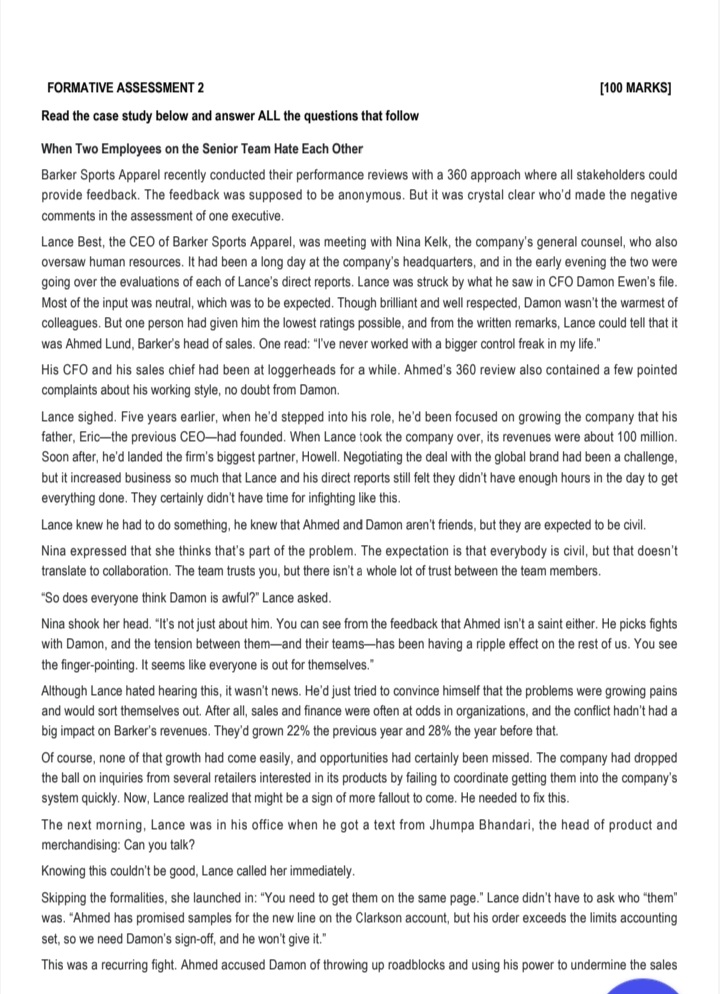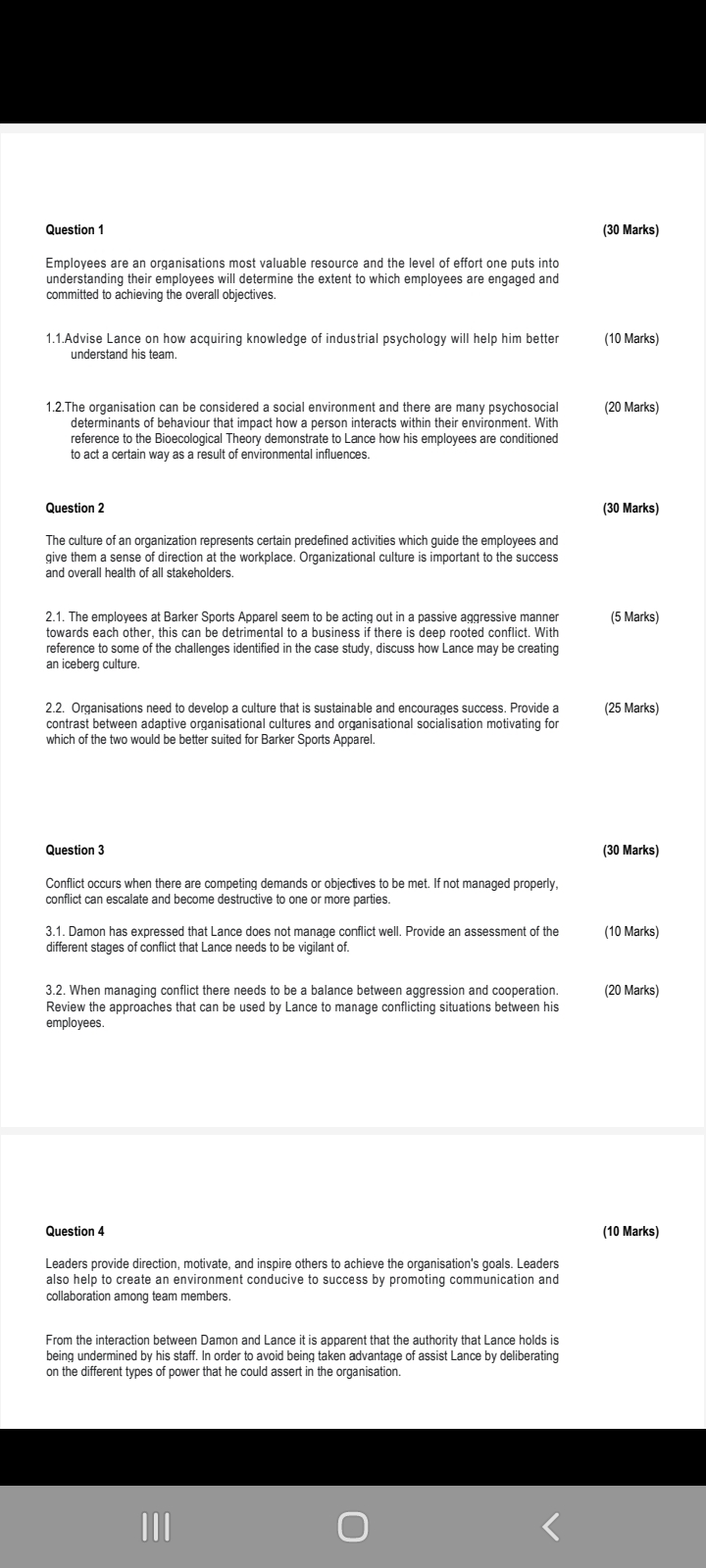Answered step by step
Verified Expert Solution
Question
1 Approved Answer
FORMATIVE ASSESSMENT 2 Read the case study below and answer ALL the questions that follow [100 MARKS] When Two Employees on the Senior Team



FORMATIVE ASSESSMENT 2 Read the case study below and answer ALL the questions that follow [100 MARKS] When Two Employees on the Senior Team Hate Each Other Barker Sports Apparel recently conducted their performance reviews with a 360 approach where all stakeholders could provide feedback. The feedback was supposed to be anonymous. But it was crystal clear who'd made the negative comments in the assessment of one executive. Lance Best, the CEO of Barker Sports Apparel, was meeting with Nina Kelk, the company's general counsel, who also oversaw human resources. It had been a long day at the company's headquarters, and in the early evening the two were going over the evaluations of each of Lance's direct reports. Lance was struck by what he saw in CFO Damon Ewen's file. Most of the input was neutral, which was to be expected. Though brilliant and well respected, Damon wasn't the warmest of colleagues. But one person had given him the lowest ratings possible, and from the written remarks, Lance could tell that it was Ahmed Lund, Barker's head of sales. One read: "I've never worked with a bigger control freak in my life." His CFO and his sales chief had been at loggerheads for a while. Ahmed's 360 review also contained a few pointed complaints about his working style, no doubt from Damon. Lance sighed. Five years earlier, when he'd stepped into his role, he'd been focused on growing the company that his father, Eric-the previous CEO-had founded. When Lance took the company over, its revenues were about 100 million. Soon after, he'd landed the firm's biggest partner, Howell. Negotiating the deal with the global brand had been a challenge, but it increased business so much that Lance and his direct reports still felt they didn't have enough hours in the day to get everything done. They certainly didn't have time for infighting like this. Lance knew he had to do something, he knew that Ahmed and Damon aren't friends, but they are expected to be civil. Nina expressed that she thinks that's part of the problem. The expectation is that everybody is civil, but that doesn't translate to collaboration. The team trusts you, but there isn't a whole lot of trust between the team members. "So does everyone think Damon is awful?" Lance asked. Nina shook her head. "It's not just about him. You can see from the feedback that Ahmed isn't a saint either. He picks fights with Damon, and the tension between them and their teams-has been having a ripple effect on the rest of us. You see the finger-pointing. It seems like everyone is out for themselves." Although Lance hated hearing this, it wasn't news. He'd just tried to convince himself that the problems were growing pains and would sort themselves out. After all, sales and finance were often at odds in organizations, and the conflict hadn't had a big impact on Barker's revenues. They'd grown 22% the previous year and 28% the year before that. Of course, none of that growth had come easily, and opportunities had certainly been missed. The company had dropped the ball on inquiries from several retailers interested in its products by failing to coordinate getting them into the company's system quickly. Now, Lance realized that might be a sign of more fallout to come. He needed to fix this. The next morning, Lance was in his office when he got a text from Jhumpa Bhandari, the head of product and merchandising: Can you talk? Knowing this couldn't be good, Lance called her immediately. Skipping the formalities, she launched in: "You need to get them on the same page." Lance didn't have to ask who "them" was. "Ahmed has promised samples for the new line on the Clarkson account, but his order exceeds the limits accounting set, so we need Damon's sign-off, and he won't give it." This was a recurring fight. Ahmed accused Damon of throwing up roadblocks and using his power to undermine the sales department. Damon retorted that Ahmed was driving the company into the ground by essentially giving products away. Lance went back and forth on whose side he took, depending on which of them was behaving worse. But he didn't want to intervene again. Why couldn't they just find a compromise? Practically reading his mind, Jhumpa said, "They'll stay in this standoff forever if you let them, they act like they're not even part of the same team." Lance thought back to the last time he'd sat down with Ahmed and Damon. Each had brought a binder filled with printouts of the e-mails they'd exchanged about a missed sale. Lance had marvelled at how long it had probably taken each of them to prepare-never mind the wasted paper. "Let me look into it," Lance said. This had become his default response. Jhumpa said, "if I were in your shoes, I would fire them both." Though Lance had always appreciated her straightforwardness, he was taken aback. "Just kidding," she added hastily. "What about having them work with a coach? we could all benefit from having someone to help us talk through how we handle conflicts and from establishing some new norms." After his conversation with Jhumpa, Lance was still thinking about the idea of letting Ahmed and Damon go. Terrifying as the thought was, it might also be a relief. He'd heard of CEOS who'd cleaned house and replaced several top execs at once. He could keep Jhumpa, Nina, and a few others and bring in some fresh blood. It would be one sure-fire way to reset the team dynamics. Later that afternoon, at the end of a regular meeting with the finance team, Lance asked Damon to stay behind. Lance enquired about the hold up on the latest project. Damon expressed that the holdup was with Ahmed and that the sales team were not cooperating. Lance had then asked Damon if everything was okay between the accounting and sales departments. Damon's response was as follows: || "Same as usual. Why? What's going on? The numbers look great this quarter. We're doing just fine." Damon added that he is the CFO and Ahmed oversees sales. So, if they are both doing their jobs well, there's going to be conflict. Damon further expressed that he is the keeper of the bottom line, and that means he is going to butt heads with a few people. Lance had heard him say this before, but Damon took it one step further this time by adding that Lance's discomfort with conflict doesn't make the working relationship any easier. They both sat quietly for a minute. Lance knew that as part of this process he'd need to examine his own leadership. Indeed, his 360-performance review had been eye-opening. His people had described him as a passionate entrepreneur and a visionary, but they'd also commented on his preference for managing one-on-one instead of shepherding the team and on his tendency to favour big picture thinking over a focus on details. Lance closed his meeting with Damon by explaining that there's a difference between productive and unhealthy conflict, and right now it feels like the organisation is filled with the latter. Adapted from: Groysberg and Baden (2019) each-other https://hbr.org/2019/01/case-study-when-two-leaders-on-the-senior-team-hate- Question 1 Employees are an organisations most valuable resource and the level of effort one puts into understanding their employees will determine the extent to which employees are engaged and committed to achieving the overall objectives. 1.1.Advise Lance on how acquiring knowledge of industrial psychology will help him better understand his team. 1.2.The organisation can be considered a social environment and there are many psychosocial determinants of behaviour that impact how a person interacts within their environment. With reference to the Bioecological Theory demonstrate to Lance how his employees are conditioned to act a certain way as a result of environmental influences. Question 2 The culture of an organization represents certain predefined activities which guide the employees and give them a sense of direction at the workplace. Organizational culture is important to the success and overall health of all stakeholders. 2.1. The employees at Barker Sports Apparel seem to be acting out in a passive aggressive manner towards each other, this can be detrimental to a business if there is deep rooted conflict. With reference to some of the challenges identified in the case study, discuss how Lance may be creating an iceberg culture. 2.2. Organisations need to develop a culture that is sustainable and encourages success. Provide a contrast between adaptive organisational cultures and organisational socialisation motivating for which of the two would be better suited for Barker Sports Apparel. Question 3 Conflict occurs when there are competing demands or objectives to be met. If not managed properly, conflict can escalate and become destructive to one or more parties. 3.1. Damon has expressed that Lance does not manage conflict well. Provide an assessment of the different stages of conflict that Lance needs to be vigilant of. 3.2. When managing conflict there needs to be a balance between aggression and cooperation. Review the approaches that can be used by Lance to manage conflicting situations between his employees. Question 4 Leaders provide direction, motivate, and inspire others to achieve the organisation's goals. Leaders also help to create an environment conducive to success by promoting communication and collaboration among team members. From the interaction between Damon and Lance it is apparent that the authority that Lance holds is being undermined by his staff. In order to avoid being taken advantage of assist Lance by deliberating on the different types of power that he could assert in the organisation. ||||| (30 Marks) (10 Marks) (20 Marks) (30 Marks) (5 Marks) (25 Marks) (30 Marks) (10 Marks) (20 Marks) (10 Marks)
Step by Step Solution
There are 3 Steps involved in it
Step: 1
Answer Question 1 11 Acquiring knowledge of industrial psychology will help Lance better understand his team in the following ways Understanding individual differences Industrial psychology provides i...
Get Instant Access to Expert-Tailored Solutions
See step-by-step solutions with expert insights and AI powered tools for academic success
Step: 2

Step: 3

Ace Your Homework with AI
Get the answers you need in no time with our AI-driven, step-by-step assistance
Get Started


